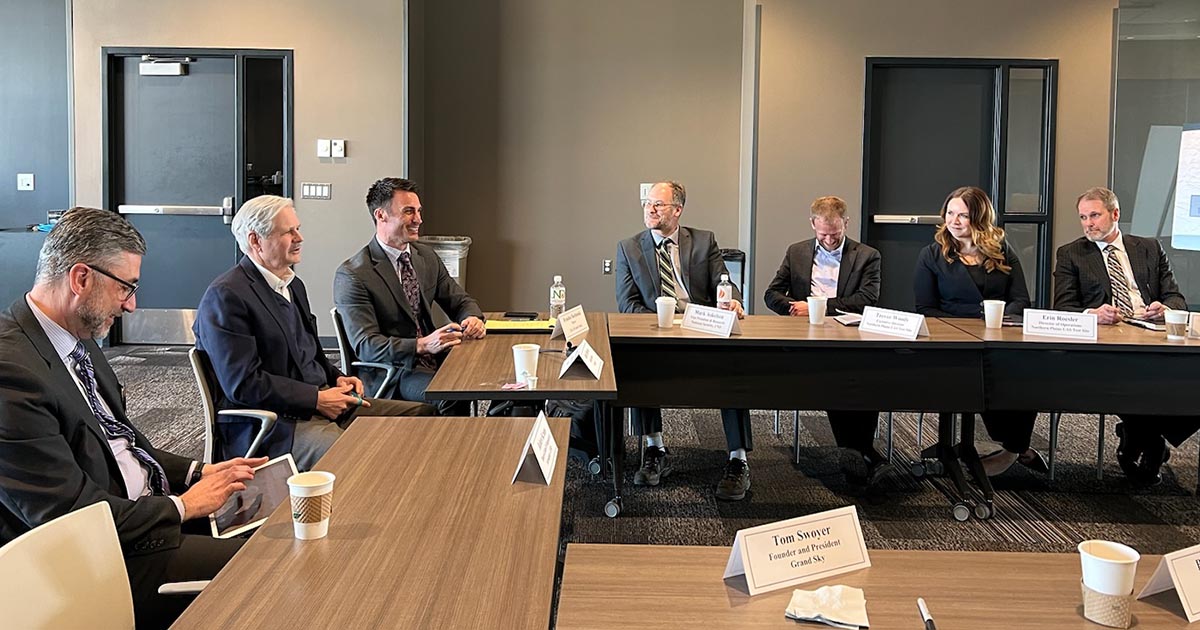Hoeven Holds Planning Session for Counter-UAP, Announces FAA BVLOS Waivers for Unmanned Flights & Outlines Economic Impact of Sky Range Program
GRAND FORKS, N.D. – Senator John Hoeven today held a meeting with leaders from the Grand Forks community, the University of North Dakota (UND), and the area’s unmanned aerial systems (UAS) industry, where he:
- Announced that that, at his urging, the Federal Aviation Administration (FAA):
- Has approved beyond-visual-line-of-sight (BVLOS) waivers for UAS flights in the region utilizing enhanced radar software.
- Will approve an additional waiver to allow the test site to host UAS flights for additional companies.
- Outlined the economic impact of Sky Range, the hypersonic missile testingprogram at Grand Sky.
- Discussed opportunities for the Grand Forks region to help secure the nation’s airspace against the threat of unidentified aerial phenomena (UAP).
“The waivers we secured from the FAA, as well as those we continue to advance, will put the Grand Forks region on track to enhance its BVLOS operations in tremendous ways, including by helping bring in new commercial-sector partners. That will be a big economic benefit to the region, as is the Sky Range program, which not only brought $2 billion worth of aircraft to Grand Sky, but will deliver hundreds of millions of dollars in value annually as the program moves forward,” said Hoeven. “These efforts align with emerging national security concerns. In particular, the recent incidents with UAPs in U.S. airspace have clearly demonstrated the need to strengthen our nation’s domain awareness capabilities. North Dakota is well-positioned to fill this need. That’s the case we continue making to our military leadership as we work to leverage assets in the Grand Forks region to ensure U.S. airspace is fully secure.”
Securing BVLOS Waivers
Specifically, the waivers secured by Hoeven support BVLOS flights conducted by the Northern Plains UAS Test Site and General Atomics, utilizing enhanced radar software. The software upgrades improve the safety and security of BVLOS flights, but required a new waiver from the FAA before being deployed. New BVLOS waivers face a lengthy approval process, and Hoeven worked to accelerate these approvals based on North Dakota’s strong track record of safe UAS operations.
Hoeven also said he is pursuing a separate waiver that will make it easier for companies to test their aircraft at North Dakota’s test site:
- Under current FAA rules, a UAS must be designated for public rather than commercial use in order to fly, even when operating under the supervision of a UAS test site.
- This restricts the companies’ ability to establish a safe operating record, which is required in order to fly UAS in the broader national airspace.
- The waiver being advanced by Hoeven would allow many companies to work within the airspace governed by North Dakota’s test site without needing a public designation, giving the state an even greater competitive edge in the UAS industry.
Economic Impact of Sky Range
Following his efforts to establish the Test Resource Management Center’s (TRMC) Sky Range program at Grand Sky, Hoeven has continued working to ensure the program moves forward and is fully funded. The program is anticipated to bring to Grand Forks:
- $2 billion in market value for the Global Hawk fleet that was transferred to Grand Sky.
- More than $100 million of additional construction at Grand Sky.
- More than $300 million in annual operations budget, which would include efforts by Northrop Grumman to convert the Global Hawks into Range Hawks for hypersonic missile testing.
Addressing the Threat of UAPs
During the meeting, Hoeven discussed the need for partnerships to improve domain awareness and ensure the nation’s airspace is secure against a variety of threats. The senator stressed how defense agencies could achieve this goal by leveraging North Dakota’s leadership in UAS and its enhanced radar systems, among other assets. The discussion builds on a recent meeting where Hoeven outlined Grand Forks’ capabilities and assets to General Glen VanHerck, Commander of the U.S. Northern Command (NORTHCOM) and North American Aerospace Defense Command (NORAD), including:
- The early warning radar at Cavalier Space Force Station.
- The RQ-4 Global Hawk Block 40, based at Grand Forks Air Force Base.
- The MQ-9 Reaper, based at Hector Field in Fargo.
- An MQ-9 variant flown by Customs and Border Protection out of Grand Forks.
- Expanded radar coverage of North Dakota airspace in support of unmanned aircraft operations near Grand Forks and eventually across the state.
- Partnerships through the Northern Plains UAS Test Site.
- UND’s research and development of counter-UAS measures.

-###-
Next Article Previous Article
